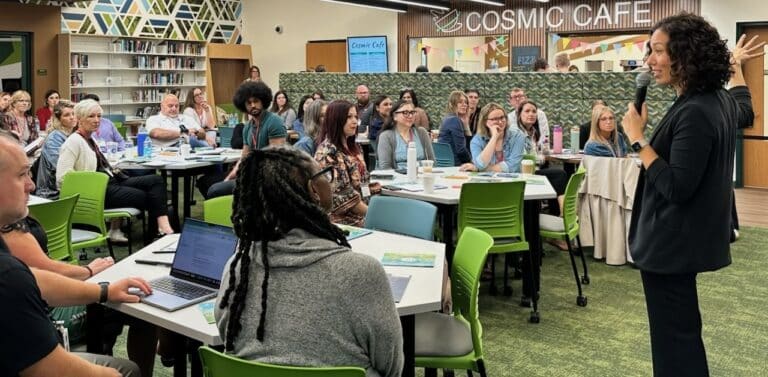Personalized, competency-based learning should be student-centered, and student voice is a large part of that. It leads to student agency and leadership. When students know themselves and can express themselves, they can bring a unique perspective to and self-advocate for their learning experience. Let’s take a look at 10 ways to encourage, activate and support student voice, featuring video insights from Julia E. Torres.
1. Ask, “Who are you?”
It’s important for learners to bring their whole selves into a learning space. What experiences, culture, identity and interests do they bring to your learning space? This can set the standard for how students can find, hone or use their voice as an agent in their own learning. It can also help educators connect with and learn from students.
Understanding what matters to Nevada’s students is part of the state’s strategy for transforming education, creating collective hope for the future. Learn more »
2. Encourage under-engaged voices.
Some students are not engaged for a variety of reasons, such as a lack of challenge, confidence or connection. Some learners can be encouraged over time to be more confident that they have good ideas, that they demonstrate their learning in meaningful ways or that they even matter as people. It’s not about being right or wrong; it’s about learning. Creating a classroom culture where students are praised for taking risks and showing courage can foster a more open and participatory learning environment.
3. Appreciate and lift underrepresented voices.
Many students who are minorities in spaces are often marginalized, intentionally or not intentionally, and left with a voice that does not seem to matter to those around them, let alone in the decisions about their own education experiences. However, it’s important to not tokenize them and rely on them to be the voice of an entire group or community. Find ways for you and others to connect and empathize with each other.
4. Make lessons personally relevant.
Learners have diverse experiences and interests. Giving students an opportunity to provide voice where they know and understand what their voice is, can help to make life connections and build confidence with familiarity. It’s a way for them to find joy and make meaning in learning.
See how learning experiences, innovation and collaboration are transforming Kentucky’s education system into one that centers the student voice. Learn more »
5. Give kids more time for processing.
It’s tough to formulate an opinion on something when you’re still trying to figure out what that opinion is. Providing that time to process and discuss with others will not only deepen understanding on a topic but will also provide time to hear other’s perspectives.
6. Allow for creative expression.
How learners express their thoughts and their learning can be powerful – and can be even more demonstrative of meeting competencies. Give students the opportunity to articulate their voice in the most powerful way for them – art, poetry, video, a podcast, a blog, an essay or another activity – that can demonstrate authentic evidence in their learning.
7. Stretch the imagination.
When a group experiences something – a story, a lesson, a discovery – together, that can be powerful. It can also spark learning through empathy and different perspectives. In supporting libraries, for example, we can foster a sense of self in finding books that reflect students. Or students can have a collective experience of reading the same book from different perspectives, based on their own experiences and interpretations. Activities where learners take on the voice of others can help students to develop empathy and be open to other perspectives.
8. Nurture curiosity.
Let learners’ curiosities – what interests them and makes them passionate – drive them through learner pathways. Curious learners can investigate a research question, formulate through research and listen to and engage in respectful discourse with articulate arguments. Curious learners create strong student voice.
Youth are using their voices to lead the fight against the climate crisis. How can educators help them? Learn more »
9. Engage different forms of leadership.
Leadership comes in many forms. Often, we assume extroverts in leadership positions. Or the loudest people. But leadership comes in many forms. Kids can demonstrate leadership by teaching and mentoring others, visual storytelling or through community engagement. They just need to be equipped with the tools to do them. When they’re not only being listened to but actually helping craft a vision for the future of learning with other stakeholders, students can help make education systems more equitable – by having a voice in schools, districts, communities and states.
10. Reconsider feedback processes.
When students give feedback on what’s working or not working for them, it helps co-create something that does work – for both of you. They can advocate for their own learning. Learners can help transition teacher-centered feedback practices into student-centered practices. Ones such technique a West Fargo educator uses is a “feedback table.”
Using the tools they learn in school, students can become independent learners and leaders through developing their voice. They can take agency over their own education, advocate for themselves and their communities and prepare for whatever the future may hold for them.






